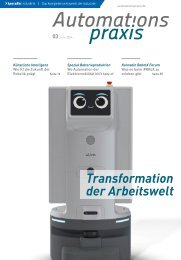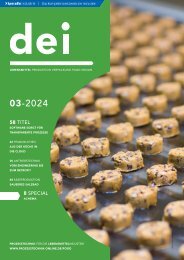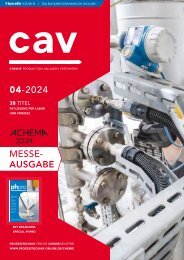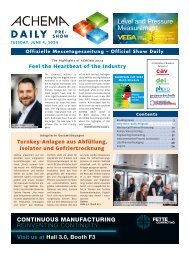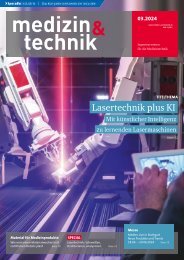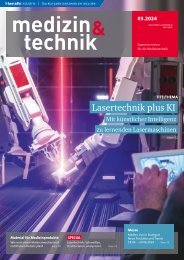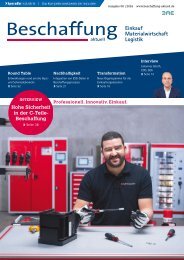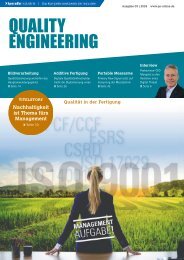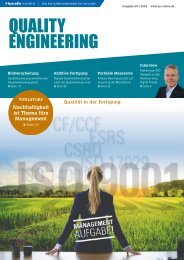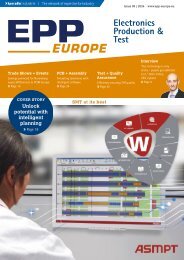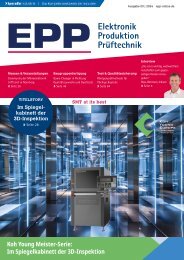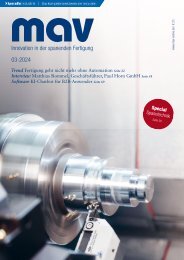cpp – Process technology for the chemical industry 01.2019
The journal cpp - Process technology for the chemical industry reports about processes, plants, apparatus and components for the chemical and pharmaceutical industry. Further topics are IT technologies, industry 4.0, digital production, MSR and automation technology and process analysis technology. The content spectrum is rounded off by explosion protection, plant safety, occupational health and safety, maintenance, site management and energy management.
The journal cpp - Process technology for the chemical industry reports about processes, plants, apparatus and components for the chemical and pharmaceutical industry. Further topics are IT technologies, industry 4.0, digital production, MSR and automation technology and process analysis technology. The content spectrum is rounded off by explosion protection, plant safety, occupational health and safety, maintenance, site management and energy management.
Create successful ePaper yourself
Turn your PDF publications into a flip-book with our unique Google optimized e-Paper software.
<strong>cpp</strong><br />
PROCESS ENGINEERING<br />
Safety concept <strong>for</strong> continuous tubular reactors<br />
Safe scale-up with<br />
exo<strong>the</strong>rmic reactions<br />
Fluitec offers a safety concept and all essential equipment <strong>for</strong> scaling up demanding<br />
<strong>chemical</strong> reactions in tubular reactors. The continuous processes are divided into<br />
safety classes based on <strong>the</strong>ir temperature levels, as a starting point <strong>for</strong> selecting<br />
and installing suitable safety devices such as a countercurrent safety purge system,<br />
safety valves or bursting discs. The use of certified assemblies results in significantly<br />
shorter development times.<br />
Chemical processes are often developed<br />
directly today in continuous operation.<br />
Owing to <strong>the</strong> small reactor volumes and <strong>the</strong><br />
high surface-to-volume ratio, even fast and<br />
highly exo<strong>the</strong>rmic reactions can be carried<br />
out safely in millireactors or microreactors.<br />
However, <strong>the</strong> question of safety requirements<br />
generally arises at <strong>the</strong> latest when<br />
<strong>the</strong>se reactions are scaled up. Fluitec has developed<br />
a safety concept <strong>for</strong> assemblies and<br />
built a reference plant with a diameter of<br />
The Fluitec mixer/heat exchanger<br />
DN 50 <strong>for</strong> throughputs from 100 to<br />
300 kg/h. The engineers responsible chose<br />
Fluitec’s proven, high-per<strong>for</strong>mance mixer/<br />
heat exchanger as <strong>the</strong> tubular reactor.<br />
Safety classification<br />
Although <strong>the</strong> reaction mass is only heated<br />
locally in a continuous process and <strong>the</strong>re is<br />
a large heat-exchanging area, <strong>the</strong>rmal runaway<br />
or an excessive pressure rise in <strong>the</strong><br />
Pictures: Fluitec<br />
tubular reactor cannot be completely ruled<br />
out. If a hazardous incident of this kind occurs,<br />
measures must be in place to prevent it<br />
from propagating to <strong>the</strong> storage tanks and<br />
collecting vessels. In practice, <strong>the</strong>se safeguards<br />
are dependent on <strong>the</strong> type of <strong>chemical</strong><br />
reaction as well as on <strong>the</strong> process conditions.<br />
At <strong>the</strong> heart of <strong>the</strong> safety concept,<br />
<strong>the</strong>re<strong>for</strong>e, is <strong>the</strong> division of continuous processes<br />
into safety classes 1 to 5 based on<br />
<strong>the</strong>ir temperature levels (modified diagram<br />
taken from F. Stoessel, Thermal Safety of<br />
Chemical <strong>Process</strong>es, Wiley-VCH, Weinheim<br />
2008). This safety classification is determined<br />
by <strong>the</strong> relative positions of <strong>the</strong> following<br />
temperatures:<br />
• T P <strong>–</strong> <strong>Process</strong> temperature range<br />
• T m = T 0 + ∆T ad <strong>–</strong> Maximum temperature<br />
attainable under adiabatic conditions<br />
• T S <strong>–</strong> Maximum allowable temperature of<br />
<strong>the</strong> pressure equipment; temperature at response<br />
pressure of <strong>the</strong> bursting discs or<br />
<strong>the</strong> safety valve<br />
• T Onset <strong>–</strong> Onset temperature of <strong>the</strong> decomposition<br />
reaction<br />
Safety classes 1 and 2 are considered to be<br />
«safe» because if <strong>the</strong> cooling system fails,<br />
<strong>the</strong> maximum attainable temperature (T m )<br />
cannot initiate <strong>the</strong> decomposition reaction.<br />
In <strong>the</strong> case of class 3, <strong>the</strong> above-mentioned<br />
incident could cause <strong>the</strong> reactor to burst,<br />
while with safety classes 4 and 5 even a decomposition<br />
reaction is conceivable. Eventpreventing<br />
protective devices such as a<br />
countercurrent safety purge system (SPS)<br />
should be installed <strong>for</strong> <strong>the</strong> class 3 to 5 reactions<br />
<strong>for</strong> this reason in addition to damage-<br />
60 <strong>cpp</strong> 01-2019




